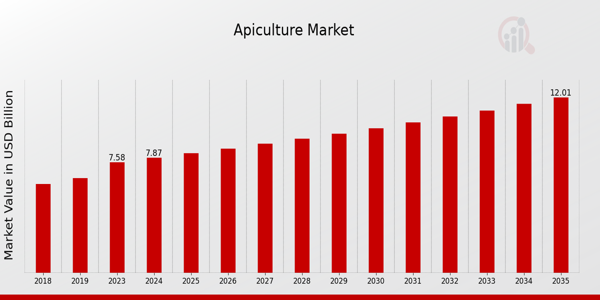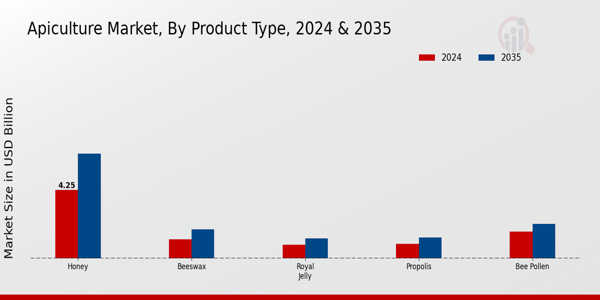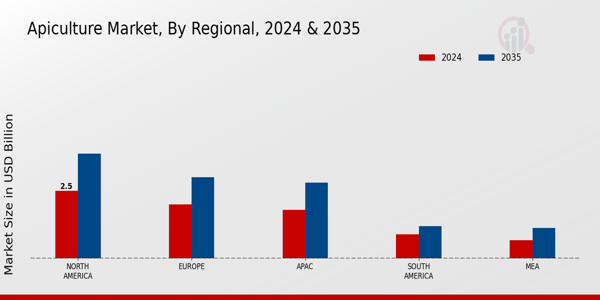Global Apiculture Market Overview
Apiculture Market Size was estimated at 7.58 (USD Billion) in 2023. The Apiculture Industry is expected to grow from 7.87(USD Billion) in 2024 to 12.0 (USD Billion) by 2035. The Apiculture Market CAGR (growth rate) is expected to be around 3.91% during the forecast period (2025 - 2035).

Source Primary Research, Secondary Research, Market Research Future Database and Analyst Review
Key Apiculture Market Trends Highlighted
The Apiculture Market is influenced by several key drivers that contribute to its growth. One of the primary drivers is the increasing consumer demand for natural and organic food products. Honey, beeswax, and other bee-related products are being viewed as healthier alternatives to refined sugars and artificial additives. Additionally, awareness of the health benefits associated with bee products, such as their antioxidant and anti-inflammatory properties, is driving sales. The rise of the wellness trend is pushing consumers toward products that promote health and sustainability, further benefiting the apiculture market.
There are several opportunities to be explored within the Apiculture Market.With the growing interest in sustainable farming practices, investing in pollinator health and bio-diverse ecosystems presents a promising avenue for expansion. Innovations in beekeeping technology and practices can enhance productivity and hive management, potentially leading to increased honey yields. Furthermore, the rise in e-commerce platforms offers beekeepers direct access to consumers, helping to streamline distribution and increase visibility for lesser-known apiculture products. Opportunities also exist in product diversification, such as developing beauty and skincare products containing honey and beeswax.
Recent trends indicate a shift towards more sustainable and eco-friendly practices within the industry.There is a growing emphasis on organic certification and ensuring ethically sourced honey, which caters to the conscious consumer market. The use of smart technologies in monitoring bee health and hive conditions is also gaining traction, enhancing overall hive management. As awareness of the crucial role bees play in pollination and food production increases, efforts to protect bee populations are becoming more prominent. This societal focus on bees and their products is likely to influence market dynamics and create new avenues for growth.
Apiculture Market Drivers
Growing Demand for Honey and Bee Products
The Apiculture Market Industry is experiencing significant growth due to the increasing demand for honey and other bee-related products. Honey is not only a popular natural sweetener but also a key ingredient in numerous dietary supplements, food products and cosmetics. As consumers become more health-conscious, there is a rising inclination towards natural and organic products, and honey fits perfectly into this trend.
The preference for natural foods, coupled with a growing awareness of the health benefits associated with honey, such as its antioxidant properties and its role in soothing ailments, is driving the expansion of the Apiculture Market.Moreover, an increasing number of consumers are shifting away from refined sugars in favor of honey, adding to the demand. The rise in e-commerce has also facilitated access to honey and other bee products, further bolstering the Apiculture Market. Stores and online platforms are increasingly offering a variety of honey types, including raw, organic, and flavored honey, catering to diverse consumer preferences.
Additionally, the culinary world’s appreciation for gourmet and specialty honey is fueling the market growth.Chefs and home cooks alike are exploring innovative ways to incorporate honey into their dishes, enhancing the overall demand for diverse honey products. Furthermore, awareness created by social media about the health benefits of natural food sources boosts consumer interest in honey. The increasing prevalence of health-food trends and an emphasis on ,clean-label products are expected to solidify honey's position in the marketplace, driving the Apiculture Market over the coming years.
Sustainable Farming Practices
The adoption of sustainable farming practices is becoming a prominent driver in the Apiculture Market Industry. Beekeeping practices that prioritize environmental sustainability help ensure the health and survival of bee populations, which in turn supports the production of honey and other bee products. As society increasingly recognizes the vital role of bees in pollination and biodiversity, sustainable apiculture methods are gaining traction.
The adoption of green initiatives mitigates the stigma associated with the use of pesticides and thus improves the perception of apiculture businesses and builds trust with consumers. This change towards sustainable agriculture practices is also evident in the branding of honey products because consumers are willing to pay a premium for more favorable positions that comply with their beliefs about sustainability and environmental responsibility.
Technological Advancements in Beekeeping
Technological advancements are transforming the Apiculture Market Industry by improving efficiency and productivity in beekeeping operations. Innovations such as smart beehives, tracking systems, and advanced monitoring tools allow beekeepers to gain valuable insights into hive health. By utilizing technology, beekeepers can better manage their operations, leading to improved honey yields and overall hive well-being. These advancements facilitate effective management practices and enable beekeepers to address challenges such as diseases and climate change, ultimately contributing to the growth of the Apiculture Market.
Apiculture Market Segment Insights
Apiculture Market Product Type Insights
In the Apiculture Market, the Product Type segment reveals significant diversity with various essential offerings, each contributing to the market's overall valuation and growth trajectory. As of 2024, the market is valued at approximately 7.87 USD Billion, reflecting the importance of the different product types derived from bees. Among these, Honey holds the majority share with a valuation of 4.25 USD Billion in 2024, projected to grow to 6.5 USD Billion by 2035.
This dominance can be attributed to honey's widespread use in culinary applications, health supplements, and as a natural sweetener, making it a staple in households and food industries worldwide. Beeswax follows as another important product, valued at 1.2 USD Billion in 2024 and expected to reach 1.8 USD Billion by 2035. Its utility in cosmetics, candles, and as a food preservative underlines its significance within the market, highlighting the versatility of products sourced from bees.
Royal Jelly, valued at 0.85 USD Billion in 2024 with projections of 1.25 USD Billion by 2035, is recognized for its health benefits and nutritional properties, appealing to wellness-oriented consumers seeking premium supplements. Propolis, another valuable product, is noted for its medicinal properties and is projected to grow from 0.9 USD Billion in 2024 to 1.3 USD Billion by 2035, making it increasingly sought after in natural health products and remedies.
Finally, Bee Pollen, valued at 1.67 USD Billion in 2024 and anticipated to climb to 2.15 USD Billion by 2035, is recognized for its rich nutritional profile, leading to its popularity in health foods and dietary supplements.
Overall, these insights into the Product Type segment of the Apiculture Market illustrate the varying contributions of each product. Collectively, these product segments reveal synergies that drive growth and highlight ongoing opportunities derived from the increasing demand for natural and organic products globally. The competitive landscape continues to evolve as consumers increasingly prioritize sustainability and health, further influencing the dynamics within the Apiculture Market data and statistics. Thus, understanding the significance of each product type, particularly those with strong growth trajectories, is critical in recognizing future trends and market dynamics.

Source Primary Research, Secondary Research, Market Research Future Database and Analyst Review
Apiculture Market Application Insights
Each of these applications plays a critical role, with Food and Beverage representing a major portion of the market share due to rising consumer preferences for natural sweeteners and functional foods. Cosmetics and Personal Care also dominate this landscape as honey and beeswax are increasingly sought after for their moisturizing properties and natural appeal in beauty products.The Pharmaceuticals sector benefits from apicultural ingredients known for their medicinal properties, while Nutraceuticals emphasize the health benefits of honey and its derivatives, driving significant demand.
The continuous innovation and growing awareness around the health advantages associated with apicultural products contribute to the expansion of these segments. Overall, the Apiculture Market demonstrates a promising trajectory, supported by increasing consumer interest in natural and organic products, while navigating challenges like regulatory compliance and sustainability.
Apiculture Market Distribution Channel Insights
The distribution channel segment of the Apiculture Market plays a crucial role in ensuring that products reach consumers effectively. Online channels are increasingly becoming prominent due to the growing trend of e-commerce and digital outreach, which allows for wider market penetration and convenience for consumers. Meanwhile, offline distribution methods, including retail stores and direct sales, continue to hold a substantial presence, catering to customers who prefer in-person purchases.Retail outlets dominate consumer interactions, offering a tactile experience that online platforms cannot replicate.
Direct sales are also important as they create a personal connection between producers and consumers, fostering brand loyalty within the Apiculture Market industry. With the continued growth in consumer awareness regarding the benefits of apiculture products, the importance of these distribution channels is expected to strengthen, thereby influencing the Apiculture Market revenue positively. Overall, this segment demonstrates a dynamic interplay between traditional and modern sales methodologies, illustrating the diverse preferences within the customer base.
Apiculture Market End User Insights
This market exhibits a diverse range of end users, with distinctions among commercial, residential, and industrial sectors, each playing a critical role in the market dynamics. The commercial sector is significant, driven by the increasing demand for honey and bee-related products which has led businesses to invest in apiculture practices, contributing to the market's robust growth.
Meanwhile, the residential segment has gained traction as more individuals embrace backyard beekeeping as a sustainable hobby, reflecting a growing consumer interest in local and organic honey production.The industrial end user demonstrates its importance as well, especially in the manufacturing of various products that utilize honey, beeswax, and other bee-derived ingredients. This diverse end user landscape highlights the potential for innovation and expansion within the Apiculture Market, fostering opportunities to address consumer preferences and sustainability concerns.
Apiculture Market Regional Insights
The Apiculture Market is poised for significant growth in the upcoming years, with a diverse landscape across various regions. North America leads the market with a valuation of 2.5 USD Billion in 2024 and is expected to reach 3.87 USD Billion by 2035, showcasing a strong demand for bee products. Europe follows closely, valued at 2.0 USD Billion in 2024, which reflects the region's historical reliance on apiculture for both agricultural practices and natural health products, and this is projected to grow to 3.0 USD Billion by 2035.
The APAC region, valued at 1.8 USD Billion in 2024, highlights a growing interest in beekeeping practices, potentially increasing its market share as awareness of health benefits rises, reaching around 2.8 USD Billion by 2035.Meanwhile, South America, with a valuation of 0.9 USD Billion in 2024, shows a modest yet significant growth trajectory up to 1.2 USD Billion by 2035, indicating expanding opportunities in local honey production. The MEA region, although the smallest segment at 0.67 USD Billion in 2024, is anticipated to see growth to 1.13 USD Billion by 2035 as interest in sustainable practices gains traction.
Overall, the regional segmentation illustrates a dynamic landscape where varying levels of market dominance are influenced by local practices, economic factors, and consumer demand.

Source Primary Research, Secondary Research, Market Research Future Database and Analyst Review
Apiculture Market Key Players and Competitive Insights
The Apiculture Market is a vital component of the agricultural economy, involving the production and trade of honey and other bee-related products. As a multi-faceted industry, it encompasses various players, from small-scale beekeepers to large multinational corporations. The market is characterized by a growing consumer demand for organic and natural products, driven by health-conscious trends and the increasing awareness of the benefits of honey and bee products. This has resulted in heightened competition among various stakeholders, with innovation and sustainable practices becoming central to the strategies employed by companies within the sector.
The competitive landscape is further influenced by regional preferences, regulatory frameworks, and the volatility of bee populations, which have created both challenges and opportunities for growth across different markets.Dabur, a prominent player in the Apiculture Market, has established a significant presence through its diverse range of honey products. The company leverages its strong brand reputation and expertise in natural healthcare, which is recognized worldwide. Its focus on quality assurance and sourcing raw materials from organic beekeeping practices enhances consumer trust in its offerings.
Moreover, Dabur's expansive distribution network allows it to reach a broader audience, establishing its presence in various international markets. The company's commitment to sustainable and ethical beekeeping practices also distinguishes it from competitors, appealing to consumers who prioritize environmental responsibility. Additionally, Dabur actively engages in marketing strategies that highlight the health benefits of honey and its versatile uses, further solidifying its position in the market.Y.S. Eco Bee Farms is another key player within the Apiculture Market, renowned for its organic and sustainably sourced bee products.
The company is dedicated to providing high-quality honey and bee-related goods that resonate with eco-conscious consumers. Its commitment to environmental sustainability has garnered a loyal customer base that values natural production methods and the health benefits associated with honey. Y.S. Eco Bee Farms emphasizes transparency in its sourcing and production processes, which enhances consumer confidence in its products. By actively participating in community initiatives and promoting education on the importance of bees and their ecosystem, the company strengthens its brand presence and connection with the community. The combination of quality products, ethical practices, and consumer engagement positions Y.S.
Eco Bee Farms favorably in a competitive landscape, catering to a growing demographic that prioritizes responsible consumption and natural health solutions.
Key Companies in the Apiculture Market Include
- Madhava Natural Sweeteners
Apiculture Market Industry Developments
-
Q2 2024: ApisProtect Launches Next-Generation Hive Monitoring Technology for Commercial Beekeepers ApisProtect announced the launch of its new hive monitoring system designed to help commercial beekeepers optimize hive health and productivity using advanced sensor technology and AI-driven analytics.
-
Q1 2024: BeeHero Raises $42M Series B to Expand Precision Pollination Platform BeeHero, an agtech startup focused on precision pollination, secured $42 million in Series B funding to accelerate the deployment of its data-driven hive management solutions and expand into new markets.
-
Q2 2024: MeliBio Announces Strategic Partnership with Narayan Foods to Launch Plant-Based Honey in Europe MeliBio, a company developing bee-free honey, entered a partnership with Narayan Foods to distribute its plant-based honey products across European retail channels.
-
Q3 2024: Australian Honey Producer Capilano Appoints New CEO Amid Global Expansion Plans Capilano, one of Australia's largest honey producers, announced the appointment of a new Chief Executive Officer to lead the company’s international growth strategy.
-
Q2 2024: Bumblebee Foods Opens New Apiculture Research and Development Center in California Bumblebee Foods inaugurated a new R&D facility dedicated to advancing apiculture science and developing innovative bee health solutions in partnership with local universities.
-
Q1 2025: India’s Dabur Launches Organic Honey Line Targeting Health-Conscious Consumers Dabur, a leading Indian FMCG company, launched a new line of certified organic honey products aimed at meeting rising demand for natural and health-focused food items.
-
Q2 2025: New Zealand’s Comvita Secures Major Export Contract with Chinese Retailer for Manuka Honey Comvita, a global leader in Manuka honey, signed a significant export agreement with a leading Chinese retailer to supply premium honey products over the next three years.
-
Q1 2024: French Startup BeeGuard Raises €8M to Scale Smart Apiary Solutions BeeGuard, a French agtech company specializing in smart beehive monitoring, closed an €8 million funding round to expand its operations and enhance its IoT-based apiary management platform.
-
Q3 2024: Betterbee Acquires Vermont Beekeeping Supplies to Expand Distribution Network Betterbee, a U.S.-based beekeeping supplier, acquired Vermont Beekeeping Supplies to strengthen its distribution capabilities and broaden its product offerings for apiarists.
-
Q2 2025: European Commission Approves New Bee Health Product from Bayer for Use in EU Bayer received regulatory approval from the European Commission for its latest bee health treatment, allowing the product to be marketed across EU member states.
-
Q1 2025: Flow Hive Launches Next-Generation Beehive with Enhanced Sustainability Features Flow Hive introduced a new version of its popular beehive system, featuring improved materials and design elements aimed at increasing sustainability and ease of use for beekeepers.
-
Q2 2024: Apis Flora and Syngenta Announce Collaboration to Develop Propolis-Based Crop Protection Solutions Apis Flora, a Brazilian bee products company, partnered with Syngenta to research and develop new crop protection products derived from propolis, targeting sustainable agriculture markets.
Apiculture Market Segmentation Insights
-
Apiculture Market Product Type Outlook
-
Apiculture Market Application Outlook
- Cosmetics and Personal Care
-
Apiculture Market Distribution Channel Outlook
-
Apiculture Market End User
Outlook
-
Apiculture Market Regional Outlook
| Report Attribute/Metric |
Details |
| Market Size 2023 |
7.58(USD Billion) |
| Market Size 2024 |
7.87(USD Billion) |
| Market Size 2035 |
12.0(USD Billion) |
| Compound Annual Growth Rate (CAGR) |
3.91% (2025 - 2035) |
| Report Coverage |
Revenue Forecast, Competitive Landscape, Growth Factors, and Trends |
| Base Year |
2024 |
| Market Forecast Period |
2025 - 2035 |
| Historical Data |
2019 - 2024 |
| Market Forecast Units |
USD Billion |
| Key Companies Profiled |
Dabur, Y.S. Eco Bee Farms, Stakich, Beehive Botanicals, Madhava Natural Sweeteners, Wedderspoon, Manuka Health, Comvita, Bee Maid Honey, Honeywell, Sambavanam Honey, Brew Hive, Dutch Gold Honey, Capilano Honey, Honey Pacifica |
| Segments Covered |
Product Type, Application, Distribution Channel, End User, Regional |
| Key Market Opportunities |
1. Organic honey demand growth, 2. Beekeeping technology advancements, 3. Pollination services expansion, 4. Sustainable product sourcing, 5. Rising health consciousness among consumers |
| Key Market Dynamics |
1. Growing demand for honey, 2. Increasing awareness of bee health, 3. Rising popularity of organic products, 4. Government support for beekeeping, 5. Technological advancements in apiculture |
| Countries Covered |
North America, Europe, APAC, South America, MEA |
Frequently Asked Questions (FAQ):
The Apiculture Market was expected to be valued at 7.87 USD Billion in 2024.
By 2035, the Apiculture Market is projected to reach a value of 12.0 USD Billion.
The expected compound annual growth rate (CAGR) for the Apiculture Market from 2025 to 2035 is 3.91%.
In 2024, North America was projected to have the largest market size in the Apiculture Market at 2.5 USD Billion.
The market value for honey in the Apiculture Market is forecasted to be 6.5 USD Billion by 2035.
Major players in the Apiculture Market include Dabur, Y.S. Eco Bee Farms, Stakich and Beehive Botanicals.
The expected market value of beeswax in the Apiculture Market by 2035 is 1.8 USD Billion.
In 2024, the Apiculture Market was divided into product types such as honey, valued at 4.25 USD Billion, beeswax at 1.2 USD Billion, and royal jelly at 0.85 USD Billion.
The market value of propolis within the Apiculture Market in 2024 was 0.9 USD Billion.
By 2035, the APAC region is anticipated to have a market value of 2.8 USD Billion in the Apiculture Market.

















